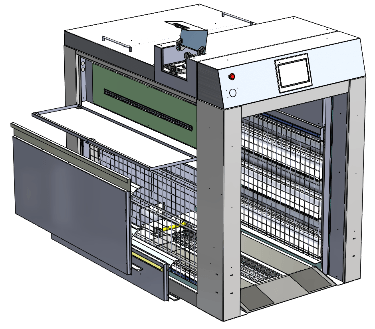| Ultraviolet Wheelchair Sterilizer
| Ultraviolet Wheelchair Sterilizer
Machine Design
Ultraviolet Wheelchair Sterilizer
The client had designed an ultraviolet wheelchair sterilizer for use by military hospitals, but the design was sufficiently flawed that the sheet metal fabrication did not work. Miro was brought in as a mechanical engineering consultant to fix/redo the design.
In tackling this mechanical engineering challenge, Miro not only addressed the sheet metal fabrication issues, he also revised the design so that it met three significant engineering challenges—one of which Miro added to the project specs himself when he saw how much it was needed:
- Make it easy to replace the UV lights, as they had to be replaced frequently.
- Keep the wheelchairs from hitting the back wall, regardless of the wheelchair size.
- Make it possible to deliver the unit without damaging it. The wheelchair sterilizer sits on the ground and is extremely heavy. There had to be a way to get it off the delivery skid and maneuver it into place.
Background
– The client had designed an ultraviolet wheelchair sterilizer for use by military hospitals, but the design was so flawed that the sheet metal fabrication did not work. Miro was brought in as a mechanical engineering consultant to work in conjunction with Patrick Hilt, the owner of Comfort Mechanical Enterprises, to redo/fix the design.
Miro started by learning all he could about the existing machine, and then he designed a new machine that, at first glance, looked quite similar to that machine, but was actually constructed quite differently.
Engineering Challenges
– In addition to ensuring that the sheet metal fabrication would work as planned based on the project’s 2D drawings and flat .dxf files, Miro addressed other engineering challenges as well. The client had identified two issues that he wanted to see solved; Miro identified a third when he delved into the operation of the existing machine:
- The wheelchair must be prevented from hitting the back wall. Furthermore, Miro felt it should be easy for the operator to quickly adjust the stopping mechanism.
- Delivering the unit cannot be impractical. The unit sits on the ground and is extremely heavy. Having a way to take it off the delivery skid and maneuver it in place was very important.
- It must be easy to replace the UV lights. When Miro studied the existing machine, he learned that the lights must be replaced frequently, and the replacement process required the operators to remove heavy parts while crawling around on their knees inside the machine. Miro found this unacceptable, and felt that the UV lights should be accessible from the outside of the machine. However, this approach presented an additional challenge. Some of the lights are located very low within the machine. These lower lights would be difficult to get to from the outside, since access is blocked by the panel that holds the unit’s heavy interior floor in place.
Solutions
– Miro created elegant solutions for each design challenge…and, of course, also prepared detailed 2D drawings and flat .dxf files that made the sheet metal fabrication work perfectly. His many design improvements included…
- An adjustable wheelchair stop ensures nothing hits the back wall. With the previous design, operators had to locate, remove and replace a small screws while crawling on their knees inside the machine. Miro created a simple mechanism that allows the operator to complete all adjustments to the wheelchair stop with just one hand, through the use of one lever.
- Pneumatically-controlled wheels drop down to ease movement. To address the issue of how to get the unit off of the skid and into place (which hadn’t been addressed at all by the previous design), Miro designed hidden wheels that are only used for installation or relocation. These pneumatically-controlled wheels are activated by a nitrogen gas cylinder. Open the nitrogen valve and the wheels drop down; close the valve and they retract back into the unit. The decision to chose use nitrogen rather than air was made based on the knowledge thatbecause all hospitals have nitrogen canisters in stock.
- UV lights are replaced from the outside. Miro designed a large access panel on the outside of the unit that is easily removed and stood up on the ground. For access to the lights at the bottom of the unit, the lower outer panel also easily lifts out.
This design not only makes UV light replacement safer and easier it also makes the unit easier to assemble and maintain, as all light replacement and assembly is done from the outside. No need to crawl inside the unit to accomplish these tasks!





